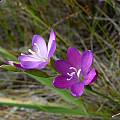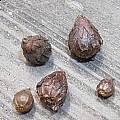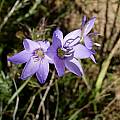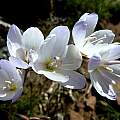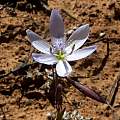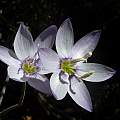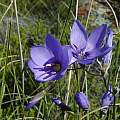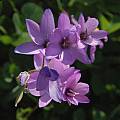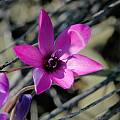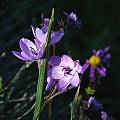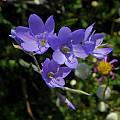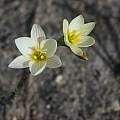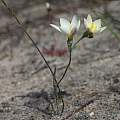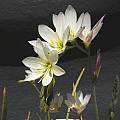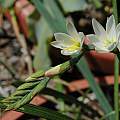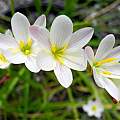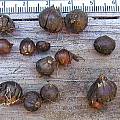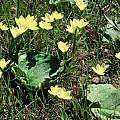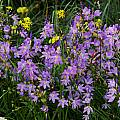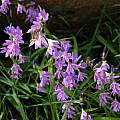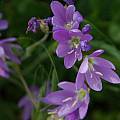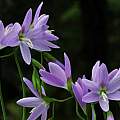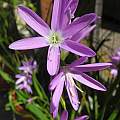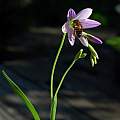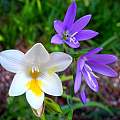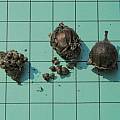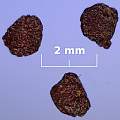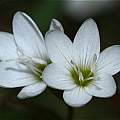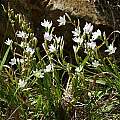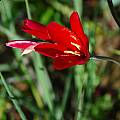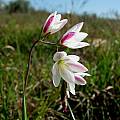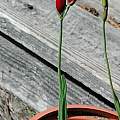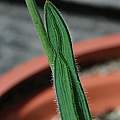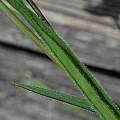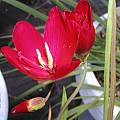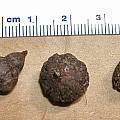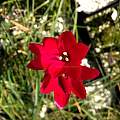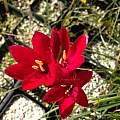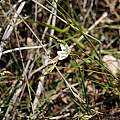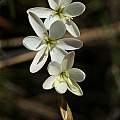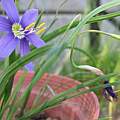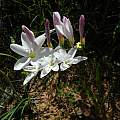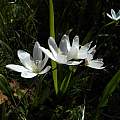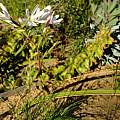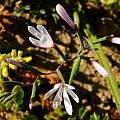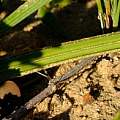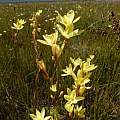Geissorhiza species h-l are found on this wiki page. See the links below for information about this genus and other species.
Geissorhiza index - Geissorhiza species a-g - Geissorhiza species m-z
Geissorhiza hesperanthoides Schltr. grows on damp and marshy mountain slopes in the Southwest Cape and blooms late spring into summer. It is a sporadic bloomer, often blooming after a fire or when vegetation has been cleared so it has more light. It has one to three blue to violet flowers and a fibrous corm tunic. Photo taken on Napier Mountain in the Overberg by Cameron McMaster.
Geissorhiza heterostyla L.Bolus is a blue to purple flowered plant that is found in a wide distribution of the South African Cape and is usually found on stony clay slopes. This species was grown from seed named Geissorhiza fulva which is another species entirely with yellow flowers. Grown by Mary Sue Ittner, photo by Bob Rutemoeller. An additional photo from Mary Sue Ittner shows the corms.
Photographs by Cameron McMaster and Mary Sue Ittner were taken in the Komsberg and near Middelpos in the Roggeveld in September in different years.
Geissorhiza hispidula (Foster) Goldbl. grows in the winter, and is found in sandy places from the Cape peninsula east. It most commonly flowers after fires. The flowers are white to cream and appear in spring. Photos by Christopher Whitehouse in the Phillipskop Mountain Reserve near Stanford.
Geissorhiza imbricata (D.Delaroche) Ker Gawl. flowers from August to November. As it grows in wet sandy flats, marshes, and next to streams in the winter rainfall areas it needs good water until it blooms. Flowers are white to cream or pale yellow, usually red on the reverse of the outer tepals. They are sometimes dark in the center. Leaves are linear to sword-shaped, ribbed with several longitudinal grooves running the entire length of the leaf. The first two photos were taken by Bob Rutemoeller and the next two (including one showing the corms) were taken by Mary Sue Ittner. The last photo from Rachel Saunders is of the pale yellow form.
Geissorhiza inaequalis L.Bolus is found on rocky slopes in heavy clay in the winter rainfall areas. Photos 1 and 2 were taken by Mary Sue Ittner in September 2006 in the Nieuwoudtville flower reserve.
This plant has been too easy in Northern California where I am finding it appearing all over my garden. It produces large numbers of tiny cormlets around the corm and they flower quickly. Still it is long blooming and tolerant of a lot of rain. Photos 1-5 by Mary Sue Ittner. Two of them show pollinators with the flowers. Photo 4 shows it flowering with Freesia lechtlinii ssp. alba. The last shows the corms on a 1 cm grid. They started falling off as I placed them on the paper, but you can still see some of the tiny cormlets. Photo 6 of seed by David Pilling.
Geissorhiza inconspicua Baker is found on mountains and flats in the southern Cape. Plants grow to 30 cm high and the small white or blue to purple flowers that appear October to November are formed in a four to seven flowered spike. Photos were taken by Andrew Harvie at the Tradouws Pass in the Overberg where they were growing in a rather protected area at the base of a cliff in one of the sidings on the pass.
Geissorhiza inflexa (D.Delaroche) Ker Gawl. is found on clay flats and slopes in the north and southwest Cape. It can be white or cream and sometimes purple or red. The red form was formerly known as v. erosa, but scientists have now discarded that name. This red one, grown from Silverhill seed, is especially beautiful. Pictures below are habitat shots. The first two were taken by Mary Sue Ittner showing a red population flowering near Tulbagh in August 2006 where it was indistinguishable from a distance from Babiana villosa which was the very same color. See habitat shots of both by looking at Babiana villosa. The next picture taken by Bob Rutemoeller near Paarl in September 2003 shows a number of white ones in flower. The last photo was taken by Cameron McMaster near Napier in the Overberg
Photos taken by Bob Rutemoeller and Mary Sue Ittner of plants grown from seed illustrating leaves, bud, flowers, and corms.
The photos below were taken by Uluwehi Knecht of the striking red form.
Geissorhiza juncea (Link) A.Dietr. is distributed on sandy flats and slopes in the western Cape. Plants grow to 40 cm high and the small white to pale yellow flowers are in a five to eight flowered spike. Flowering occurs between August and November. Photos were taken by Andrew Harvie on Table Mountain in a drip cliff along the track up from Constantia Nek.
Geissorhiza karooica Goldblatt is known from two locations in the Karoo desert. It is a dwarf species, typically under 6 cm (2.4 inches) tall. It's probably closely related to Geissorhiza spiralis and Geissorhiza corrugata, both of which also grow in the Karoo. But those species have twisted leaves, while G. karooica has straight ones. Photo by Gordon Summerfield.
Geissorhiza leipoldtii R.C.Foster flowers in late winter, early spring. It is found in the Northwest Cape on mostly south-facing shale slopes. Flowers are white, pink or mauve. Photos from iNaturalist were taken by Roy Herold on the West Coast in September and shared under a CC BY-NC license.
Geissorhiza longifolia(G.J.Lewis) Goldblatt, syn. Engysiphon longifolius G.J.Lewis, grows in stony, often shale soils in the Northwestern Cape. It grows from 12 to 20 cm high and flowers from September to November. Flowers are white, fading pink with darker veins; leaves are linear with margins raised into wings and sticky with sand adhering. Photos from iNaturalist taken by Nick Helme in September and shared under a CC BY-SA license. He wrote there that this species is quite common in recently burned rocky sands.
Geissorhiza louisabolusiae R.C.Foster is restricted to wet sandy flats and vleis in the Olifants River Valley and adjacent valleys to the west of the Olifants River Mountains. Growing from 15 to 20 cm and flowering August to September, it has pale yellow flowers in a 3 to 7 flower spike. The photo was taken by Rachel Saunders in the Kouebokkeveld Mountains, at the top of the Gydo pass where plants were flowering with pink Drosera cistiflora and light blue Babiana lineolata. This area is colder and higher so there were still flowers in October 2016.
Geissorhiza index - Geissorhiza species a-g - Geissorhiza species m-z
